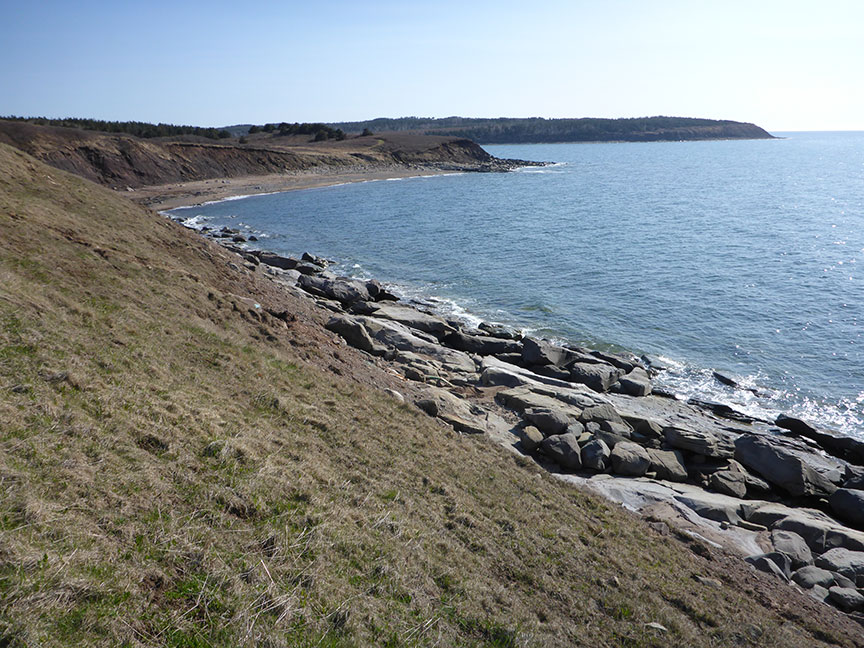Capsizing of the fishing vessel Ocean Star II
Port Hood, Nova Scotia
The occurrence
On at approximately 0415 Atlantic Daylight Time, the 8.69 m fishing vessel Ocean Star II, with 3 people on board, departed the wharf located near the community of Port Hood, Nova Scotia, to haul lobster traps. The wind was westerly at 10–15 knots and there was a 2 m northwest swell.
At approximately 0430, the Ocean Star II arrived at its first set of 2 lobster traps and the crew began to haul, and then reset each set of traps before recovering the next.
At approximately 0558, the Ocean Star II arrived at a set of lobster traps approximately 0.05 nautical miles (100 m) from the shoreline at Colindale, Nova Scotia, and just north of Sutherlands Cove. The buoy marking this set of traps was recovered and the buoy rope was placed in the hauler to recover the traps. The vessel’s bow was pointing toward the shoreline and the stern was facing the northwest swells. A large wave hit the vessel on the stern and water washed over the stern, flooding the working deck. The master began to turn the vessel to starboard to take the waves on the bow, however, during the turn, another wave hit the vessel on the starboard side and the vessel capsized.
All 3 crew members survived the initial capsizing. Deckhand 1 surfaced underneath the aft working deck of the overturned vessel before swimming out from underneath it. The master surfaced approximately 7.6 m (25 feet) from the vessel in the direction of the shoreline. Deckhand 2, who was already on top of the overturned vessel, helped Deckhand 1 onto the vessel hull.
Shortly after, another wave washed the 2 deckhands from the overturned vessel and toward the shoreline. Deckhand 1 began to swim toward the shore. A nearby fishing vessel saw the overturned Ocean Star II and proceeded toward it, alerting other vessels in the area on very high frequency (VHF) radiotelephone channel 06, the local working channel. When the fishing vessel approached the Ocean Star II, none of the 3 crew members were visible. The fishing vessel could not approach the beach or get alongside the overturned vessel due to shallow water in the area.
Deckhand 1 reached the beach and began walking along the shoreline in search of the other crew members. He located Deckhand 2 near the shore, floating in approximately 1 m of water. Deckhand 1 pulled Deckhand 2 onto the shore and performed CPR on him. Another fishing vessel arrived at the shore and the crew assessed the situation and placed a call to 911 by cellphone. Deckhand 2 remained unresponsive, so Deckhand 1 stopped performing CPR and searched for the master without success. Deckhand 1 then walked to a nearby house to seek help. The master’s body washed ashore near Deckhand 2 a short time later.
None of the crew was wearing personal flotation devices (PFDs) or any other type of lifesaving equipment. However, 4 PFDs, including 2 inflatable type and 1 lifejacket, were recovered on the shoreline. Both inflatable PFDs had inflated when the vessel capsized.
The capsizing occurred rapidly and there was no time to make a distress call. The vessel was not fitted with an emergency position-indicating radar beacon (EPIRB); however, one may not have been required depending on the combination of other safety equipment carried on board in accordance with the Fishing Vessel Safety Regulations. The sighting of the overturned Ocean Star II was the first indication of distress.
Media materials
Deployment notice
TSB deploys a team of investigators to Colindale, Nova Scotia, following the capsizing of the fishing vessel Ocean Star II
Dartmouth, Nova Scotia, 13 May 2018 — The Transportation Safety Board of Canada (TSB) has deployed a team of investigators to Colindale, Nova Scotia, following the capsizing of the fishing vessel Ocean Star II which led to the loss of life of two fishermen. The TSB will gather information and assess the occurrence.
Class of investigation
This is a class 5 investigation. Class 5 investigations are limited to collecting data, which are then stored in the modal database. If TSB investigators deployed to the occurrence site, a short description of the occurrence is posted to the TSB website once the investigation has been completed. These investigations are generally completed within 90 days. For more information, see the Policy on Occurrence Classification.
TSB investigation process
There are 3 phases to a TSB investigation
- Field phase: a team of investigators examines the occurrence site and wreckage, interviews witnesses and collects pertinent information.
- Examination and analysis phase: the TSB reviews pertinent records, tests components of the wreckage in the lab, determines the sequence of events and identifies safety deficiencies. When safety deficiencies are suspected or confirmed, the TSB advises the appropriate authority without waiting until publication of the final report.
- Report phase: a confidential draft report is approved by the Board and sent to persons and corporations who are directly concerned by the report. They then have the opportunity to dispute or correct information they believe to be incorrect. The Board considers all representations before approving the final report, which is subsequently released to the public.
For more information, see our Investigation process page.
The TSB is an independent agency that investigates air, marine, pipeline, and rail transportation occurrences. Its sole aim is the advancement of transportation safety. It is not the function of the Board to assign fault or determine civil or criminal liability.

